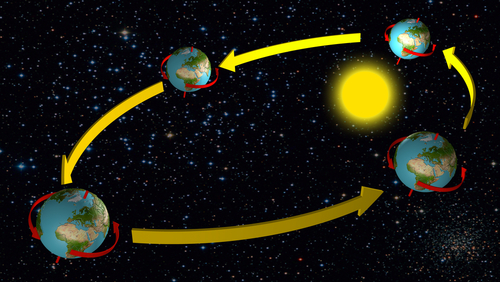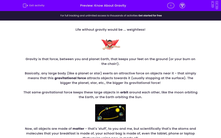Life without gravity would be ... weightless!

Gravity is that force, between you and planet Earth, that keeps your feet on the ground (or your bum on the chair!).
Basically, any large body (like a planet or star) exerts an attractive force on objects near it - that simply means that this gravitational force attracts objects towards it (usually stopping at the surface). The bigger the planet, star, etc., the bigger its gravitational force!
That same gravitational force keeps these large objects in orbit around each other, like the moon orbiting the Earth, or the Earth orbiting the Sun.

Now, all objects are made of matter - that's 'stuff', to you and me, but scientifically that's the atoms and molecules that your breakfast is made of, your school bag is made of, even the tablet, phone or laptop that you're using now, is made of!
The amount of matter in any object is a measure of its mass. More matter = more mass. Makes sense, really!
Mass is measured in simple units like grams (g) and kilograms (kg).

Very Important: the mass of something doesn't change, no matter how much gravity is pulling on it. So, if your pen has a mass of 20 g, then whether it's here on Earth, floating in space or landing on the moon in a NASA spacecraft, it's still a 20 g pen. Yes? That's unless you chew the end off it, of course - then some of its mass has gone!
So, what's weight? Well, that's calculated using a very straightforward formula (which you already know):
w = m x g
where 'w' stands for 'weight', 'm' stands for 'mass' and 'g' stands for 'gravity strength'.
Let's try it out:
Here, on Earth, the strength of the gravitational field is 10 N/kg (which simply means that each kg weighs 10 N)
In the formula above, g = 10, OK?
Let's imagine a dog (let's call him Rex), that has a mass of 20 kg:

So, to find out how much Rex weighs on Earth, we use the formula w = m x g:
Weight of Rex = 20 kg x 10 N/kg, so Rex weighs 200 N. Got that?
If we move Rex to the moon (with a doggy spacesuit, of course!), he'll weigh only 1/6 of what he weighs on Earth, as the moon's a lot smaller and the gravitational field there is only 1/6 of what it is on Earth. How would we work that out?
w = 20 kg x 1.6 N/kg = 32 N (that's a lot less than 200 N!).
Now, how about going over all that again to make sure you've got that nailed before tackling the questions. Yes?
Remember that you can always look back at this introduction at any point by clicking on the red help button on the screen.









